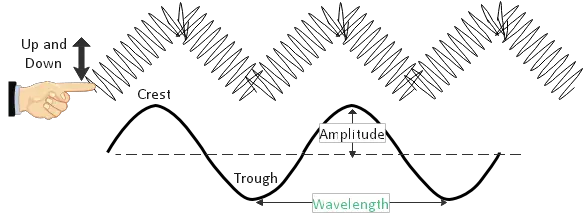Difference between transverse and longitudinal wave
The main differences between transverse and longitudinal waves in physics are presented in a simple and easy-to-read way as follows:
1. Particle Displacement:
- Transverse Wave: Particles of the medium vibrate perpendicular to the direction of wave propagation. Imagine shaking a rope up and down, while the wave itself travels horizontally.
- Longitudinal Wave: Particles of the medium vibrate parallel to the direction of wave propagation. Imagine squeezing a slinky back and forth, creating alternating regions of compression and rarefaction that travel along the slinky.
2. Compressions and Rarefactions:
- Transverse Wave: Defined by crests and troughs, which are the high and low points of the wave, respectively. These correspond to the displacement of the medium perpendicular to the wave's direction.
- Longitudinal Wave: Defined by compressions (high-pressure regions) and rarefactions (low-pressure regions) created by the back-and-forth movement of particles. These regions correspond to the density variations in the medium.
3. Wavelength:
- Both: The distance between two repeating points in the wave, such as two consecutive crests, troughs, compressions, or rarefactions.
4. Medium Requirements:
- Transverse Wave: Requires a medium with some rigidity to transmit the perpendicular vibrations. Examples include strings, membranes, and solids.
- Longitudinal Wave: Can propagate through fluids and gases due to their ability to be compressed and rarefied. Solids can also transmit longitudinal waves.
5. Energy Transfer:
- Transverse Wave: Energy and momentum are transferred by restoring forces between adjacent parts of the medium, causing a domino effect of perpendicular displacements.
- Longitudinal Wave: Energy and momentum are transferred by alternating pressure changes caused by compressions and rarefactions pushing and pulling on neighboring particles.
6. Examples:
- Transverse Wave: Water waves, waves on a string, light waves, radio waves
- Longitudinal Wave: Sound waves, seismic waves (P-waves)
The mathematical relationship between wavelength $\lambda$, frequency $f$, and wave speed ($v = f\lambda$) holds for both types of waves.
Be aware that only the disturbance travels in the wave, not the medium itself. The particles in the medium simply oscillate around their equilibrium positions.
You can also check out the difference between electric and magnetic force.
The difference between transverse and longitudinal waves is pictured in the following diagrams.
Setup of a longitudinal wave with its waveform.

Setup of a transverse wave with definitions of amplitude and wavelength.

Last Updated: Feb 25, 2024
© 2015 All rights reserved. by Physexams.com
AP® is a trademark registered by the College Board, which is not affiliated with, and does not endorse, this website.
